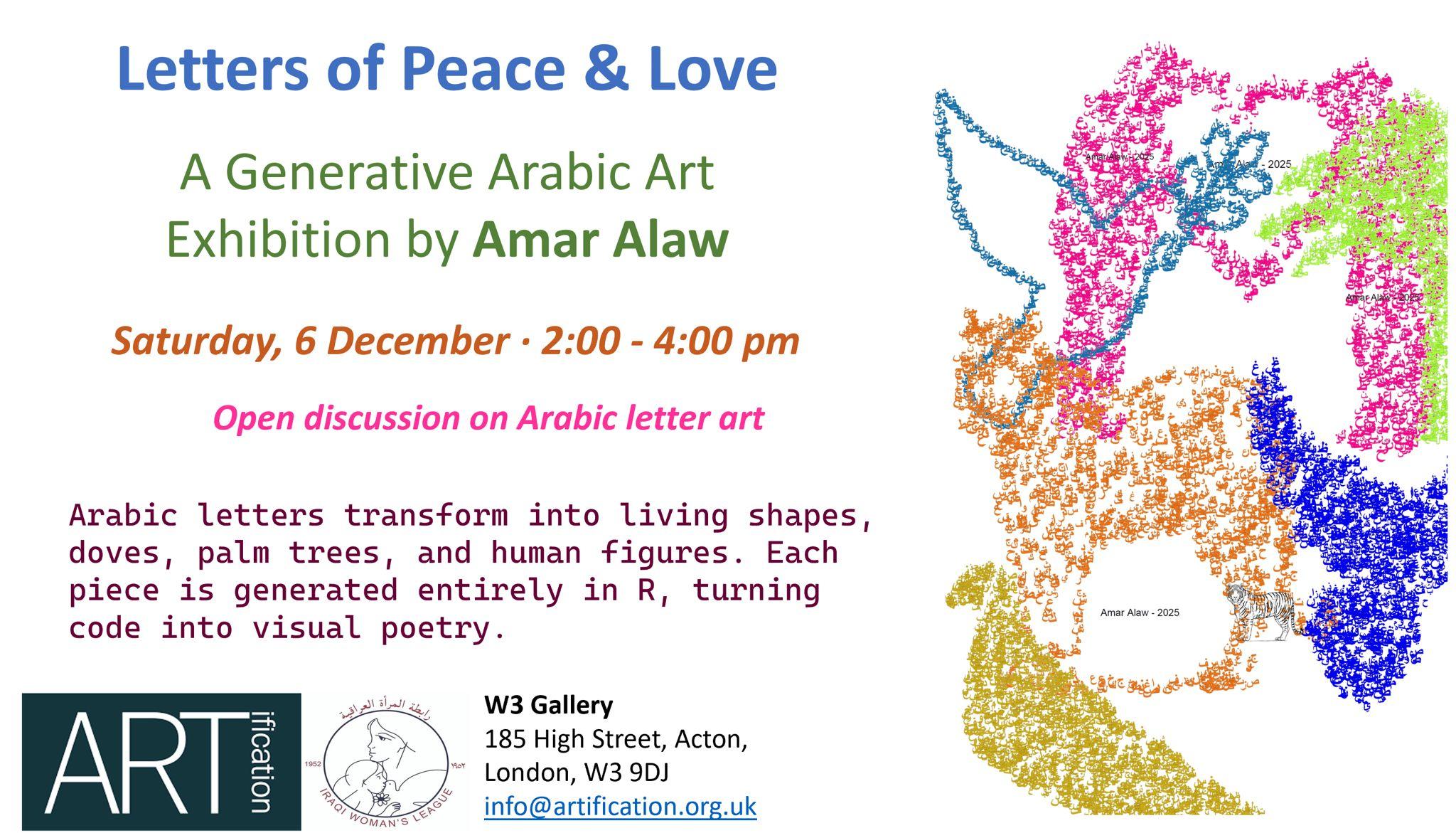A Continuous Creative Thread: Finding Home Through Art - From Europe to Acton.
Amar Alaw and the importance of his recent activities: Artist and Musician, [and a Poet], in the W3 Gallery.
By Adnan Rojeab
Iraqi-German artist and musician Amar Alaw found not just a venue but a true artistic home in W3 Gallery and ARTi - fication, a relationship that has nurtured his creative evolution from early European exhibitions to his current generative Arabic-letter works.
Before finding his sanctuary in Acton, Amar exhibited throughout Europe, with notable appearances at Munichs Haus der Kunst, Scholz-Sorger Gallery, and cultural platforms associated with the European Patent Office and FMDK in Germany. His early work explored Sumerian and Mesopotamian aesthetics, examining the profound connections between language, origins, and memory.
A pivotal moment came with "Celebrating Sanctuary," an exhibition created and curated by Amar in partnership with ARTi - fication. Hosted at W3 Gallery, this project transcended traditional art presentation, becoming a powerful cultural haven where visual art, migration narratives, and Amars Iraqi Maqam-inspired performances converged. For many in the community, including Amar himself, the gallery transformed into a space of belonging, a true artistic home where diverse experience were honoured.
W3 Gallery deepened its role as Amars creative anchor through Refugee Week exhibitions, where his contributions highlighted displacement while affirming the possibility of finding new roots through artistic expression. These events solidified the gallerys status as both a physical and emotional home for artists navigating complex cultural identities.
Year after year, Amar Alaw returned to W3 Gallery and Acton Pavilion, exhibiting, performing, leading cultural activities, and crafting experiences that connected his heritage with local community members. This ongoing relationship provided the stability and support from which his art could flourish and evolve. The gallery became not just a place to display work, but a foundation from which to build a new sense of home through creative expression.
From this secure base, Alaw developed his distinctive artistic language blending Arabic letterforms with computational methods and R-based generative algorithms. The sense of belonging fostered at W3 Gallery enabled him to confidently bridge ancient -script- traditions with contemporary digital processes, creating a new visual vocabulary that speaks to global audiences.
This artistic home supported Amar Alaws international growth. Through teaching and workshops at New York University, he introduced international audiences to generative Arabic-letter art and its cultural foundations. His inclusion in NYU s Sufi Art & Data Science Lib-Guide acknowledges his contribution to this interdisciplinary field, an achievement built on the foundation of creative security established at W3 Gallery.
Now, with his exhibition "The Plight of the Oppressed," Amar Alaw returns once more to W3 Gallery, the space that has consistently provided not just walls for his art, but genuine belonging for his artistic spirit. The exhibitions themes of dignity, adversity, and peace echo the sanctuary he found and helped create within this community space. Accompanying workshops and talks extend this sense of home to others, continuing W3 Gallerys commitment to providing creative refuge.
This dialogue continues with Amar Alaw s upcoming "Letters of Peace & Love" exhibition, where Arabic letters transform into symbols of life and hope through R-generated visual poetry. The exhibition includes open discussions on Arabic letter art, reflecting how W3 Gallery and Amar Alaw together demonstrate that artistic homes are built not just through physical space but through sustained relationships, shared values, and mutual creative growth.
Across all phases of his artistic journey, European exhibitions, "Celebrating Sanctuary," Refugee Week contributions, musical performances, community collaborations, and digital innovations, one truth remains constant: W3 Gallery has been more than a venue for Amar Alaw. It has been a true artistic home where heritage, experimentation, and humanity continue to thrive, proving that when art and community converge, they can create the most meaningful kind of sanctuary.


Comments